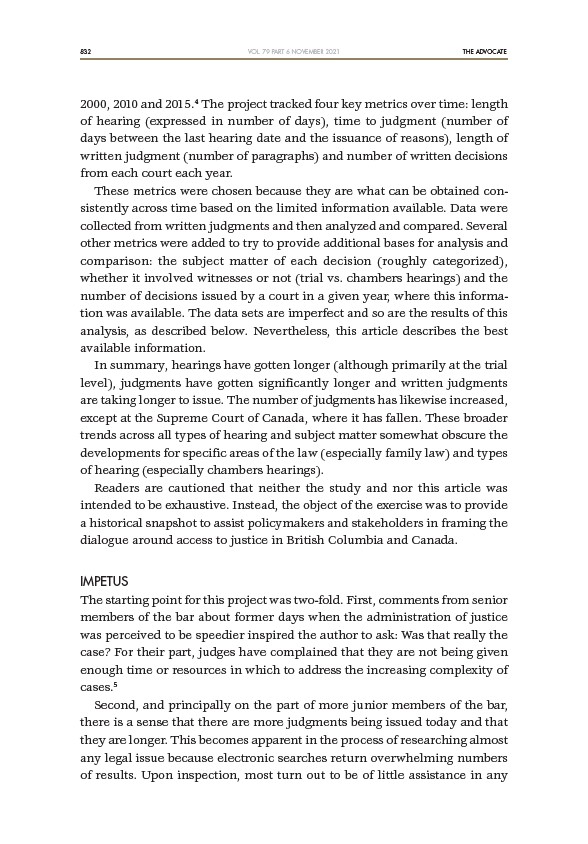
832 THE ADVOCATE
VOL. 79 PART 6 NOVEMBER 2021
2000, 2010 and 2015.4 The project tracked four key metrics over time: length
of hearing (expressed in number of days), time to judgment (number of
days between the last hearing date and the issuance of reasons), length of
written judgment (number of paragraphs) and number of written decisions
from each court each year.
These metrics were chosen because they are what can be obtained consistently
across time based on the limited information available. Data were
collected from written judgments and then analyzed and compared. Several
other metrics were added to try to provide additional bases for analysis and
comparison: the subject matter of each decision (roughly categorized),
whether it involved witnesses or not (trial vs. chambers hearings) and the
number of decisions issued by a court in a given year, where this information
was available. The data sets are imperfect and so are the results of this
analysis, as described below. Nevertheless, this article describes the best
available information.
In summary, hearings have gotten longer (although primarily at the trial
level), judgments have gotten significantly longer and written judgments
are taking longer to issue. The number of judgments has likewise increased,
except at the Supreme Court of Canada, where it has fallen. These broader
trends across all types of hearing and subject matter somewhat obscure the
developments for specific areas of the law (especially family law) and types
of hearing (especially chambers hearings).
Readers are cautioned that neither the study and nor this article was
intended to be exhaustive. Instead, the object of the exercise was to provide
a historical snapshot to assist policymakers and stakeholders in framing the
dialogue around access to justice in British Columbia and Canada.
IMPETUS
The starting point for this project was two-fold. First, comments from senior
members of the bar about former days when the administration of justice
was perceived to be speedier inspired the author to ask: Was that really the
case? For their part, judges have complained that they are not being given
enough time or resources in which to address the increasing complexity of
cases.5
Second, and principally on the part of more junior members of the bar,
there is a sense that there are more judgments being issued today and that
they are longer. This becomes apparent in the process of researching almost
any legal issue because electronic searches return overwhelming numbers
of results. Upon inspection, most turn out to be of little assistance in any